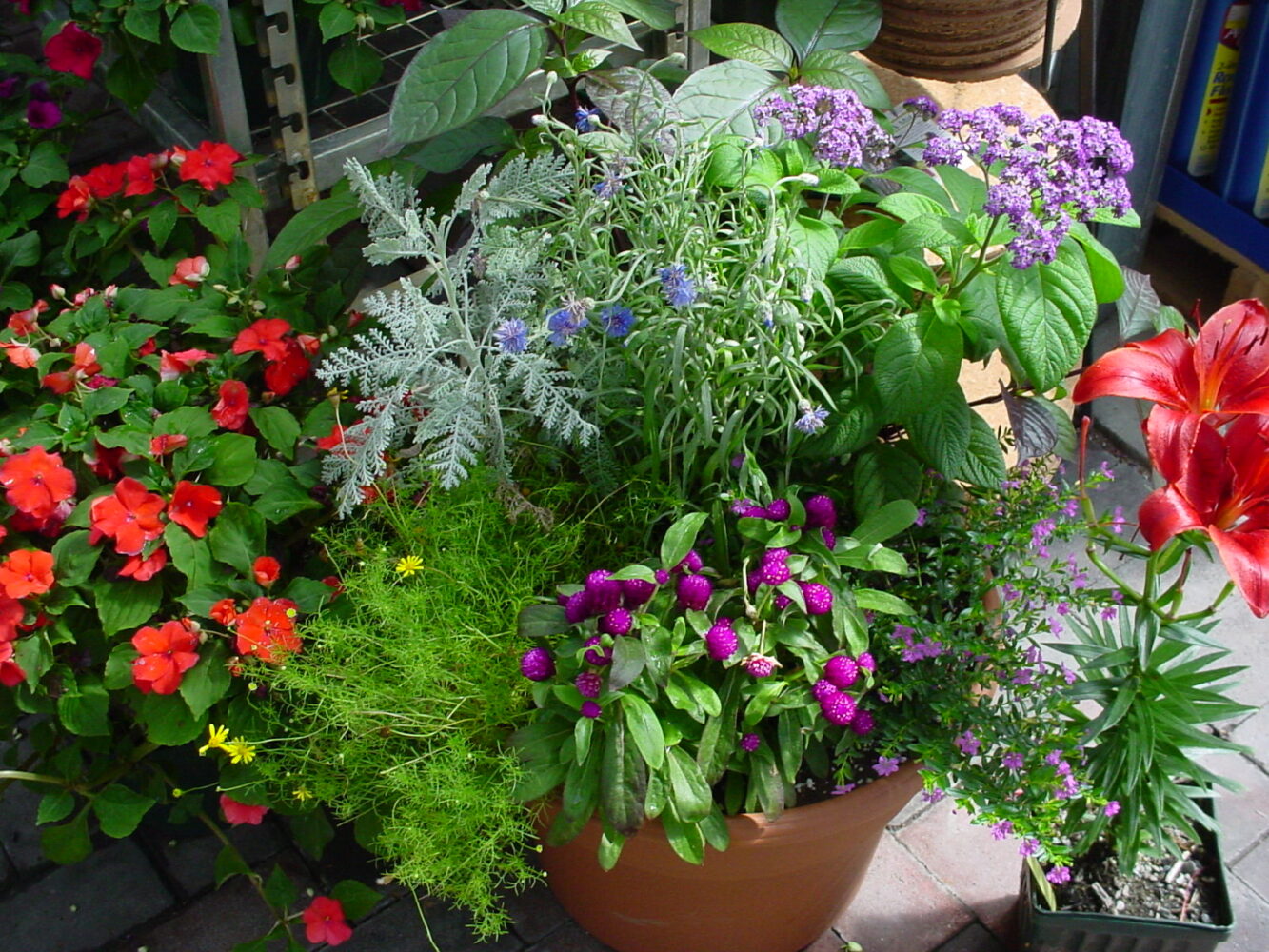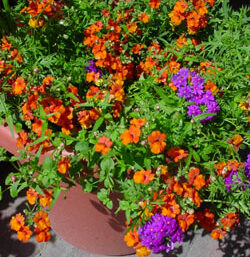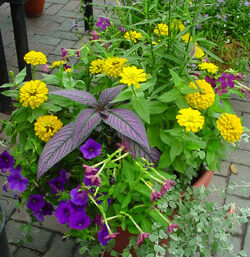Containers – Time to photogragh!

Now that most of us always have a mobile phone on us, we always have a camera! Take photos of plants and plant combinations you like and recreate the look for yourself!
Maybe you’d like to try a new flower combination but starting up a “full-sized specialty garden” sounds too expensive and then, ugh, what if you don’t like it?
For something more manageable, consider a few containers to add new definition to your sidewalk, deck or patio. Anything that holds soil and drains can be a container–let your imagination go! You can do themes:
- plants of similar colors but different shapes,
- all the same arrangement in repetition or
- unique specimens to balance each unique pot.
- try combining tropicals with perennials and annuals (However, plant your perennials in the ground before winter and bring tropicals inside if you wish to save them.)
Consider where your containers will go and match the pot’s plants to the available light. Sun-loving plants need a minimum of 6 hours of sun but for shade lovers that can be too much. So choose your plant combinations wisely.
Here are some basic guidelines for success:
-
- Choose a container that can hold the plant. Annuals can handle crowding as long as you water and fertilize regularly. Large annuals, like cannas, elephant’s ears, or dahlias need a pot that is 20 inches high and from 18 to 24 inches in diameter, but there will still be room for a few small flowers to trail out around the edges. For a smaller centerpiece (say tuberous begonia, coleus or small trio of impatiens, begonias or marigolds) with trailing ivy or sweet potato vine, you can use a container 10 to 12 inches deep and across.
- Plant in lightweight potting soil. Your container plants will need to stay moist but not waterlogged. Potting soil mixes are formulated to retain moisture while still draining well. Garden soil is usually too high in clay content and will hold too much water. Remember that your container needs to drain. You can put screening material over the hole in the bottom so that soil does not run out with the water.
- Fertilize with slow-release fertilizer at planting time. Just mix it into your potting mix so it’s available at the root zone of your plants. This fertilizes your plants every time you water for over 3 months. With the slow-release system, you’ll know your soil has the nutrients to keep your plants healthy. For fuller blooms, add a blossom-booster fertilizer (10-50-10 ratio) in your watering can every 2 weeks. When watering, nip off the spent flowers to prevent them from going to seed. This will encourage new growth and flowers.
- Get to know your containers and establish a watering routine. The real trick to beautiful healthy containers is monitoring their moisture. A daily dose of water will be required in hot sunny weather and maybe even two doses—one in the morning and again at midday—during extreme heat. The kind of container you chose will make a difference. Small terra cotta pots holding a quart of soil dry out quicker than a large plastic pot with 2 gallons of soil. Water slowly and gently allowing the water to reach all the soil in the pot and to begin draining out the bottom. Be sure to empty the saucer if you have one. Roots left in a puddle of water will rot. By checking soil often, you’ll get a feel for how often containers need water.
Tip: do the weight test especially for hanging baskets. After a slow thorough watering, push up on the bottom of the pot. You can tell it’s heavy with moisture. Push against the pot again in a few days and if it lifts easily, it’s time to refill with moisture.
So, try something a little different this summer without spending a fortune.
Record your Successes and Mistakes:
- Take digital photos of your containers throughout the summer as they grow into the pot.
- Your camera/phone stamps the date on the image and you have a visual record of the plant, the colors and the size.
- Maybe you smashed too many plants into a container or maybe 3 plants filled it beautifully.
- No matter what, take a picture! Save the tags and you will have the plant names when you shop for plants again next year.
- And, if plants were flooded or dried up, you can pick up some fresh (and larger plants) in our summer Annuals sale usually in mid-July.
Our Summer Garden Advice
By mid-summer, perennial gardens can start to look overgrown, annual flowers begin to fade, and bugs may be munching on your vegetables.
Summer Articles













